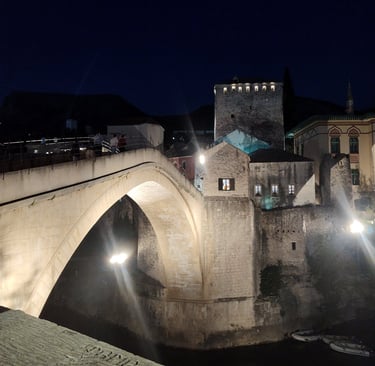Ask me about getting FREE prepaid gratuities on NCL balcony and above select sailings! Restrictions apply; offer valid 10/24/2025-10/31/2025
Off the Beaten Path: Bosnia and Herzegovina
Our trip to Mostar and Sarajevo
PUBLISHED
10/24/20253 min read


Bridging Worlds: A Journey Through Mostar and Sarajevo
Nestled in the heart of the Balkans, Bosnia and Herzegovina is a country defined by connection—between past and present, East and West, people and place. Nowhere is this more beautifully expressed than in the cities of Mostar and Sarajevo, where ancient cobblestones tell stories of resilience and renewal, and the rhythm of daily life flows with the rivers that wind through them.
Mostar: Where the Bridge Unites Worlds
Mostar’s soul is embodied in its iconic Stari Most (Old Bridge), an elegant 16th-century Ottoman arch stretching gracefully over the emerald Neretva River. Once destroyed, then lovingly rebuilt, the bridge stands as a symbol of connection and reconciliation. Around it, narrow cobblestone lanes twist through the Old Bazaar, where artisans sell copperware, handwoven rugs, and delicate filigree jewelry.
From the riverside cafés, you can watch young divers leap daringly from the bridge into the cool waters below—a local tradition celebrating courage and community. Framed by rugged mountains and dotted with minarets and stone houses, Mostar’s skyline captures the poetry of a place where time seems to stand still.
Sarajevo: The Crossroads of Cultures
A few hours north, Sarajevo welcomes travelers with the warmth of a city that has lived through centuries of change. Here, Ottoman mosques, Austro-Hungarian facades, and modern architecture coexist in graceful harmony. Stroll through Baščaršija, the Old Market, where the aroma of freshly brewed Bosnian coffee mingles with the scent of grilled ćevapi and sweet baklava.
As you walk its stone-paved streets, you’ll pass copper smiths hammering intricate designs, hear the call to prayer echo alongside church bells, and feel the unique spirit of coexistence that defines the city. The surrounding Dinaric Alps rise dramatically above the valley, offering breathtaking views and hiking trails that reveal Sarajevo’s natural serenity beyond its urban charm.
Taste of Tradition: Bosnian Tufahija (Poached Apples with Walnuts and Syrup)
No Bosnian meal feels complete without something sweet to share. Tufahija, a dessert of baked or poached apples filled with ground walnuts and bathed in fragrant sugar syrup, is a symbol of comfort and togetherness. Served chilled, often with whipped cream on top, it’s a reminder that simplicity can be deeply satisfying. I was fortunate enough to try this at a small open air cafe in Sarajevo with coffee, of course!
Ingredients:
4 large firm apples (like Granny Smith or Golden Delicious)
1 cup sugar
2 cups water
½ lemon (juice and zest)
1 cup ground walnuts
2 tablespoons sugar (for the filling)
1 tablespoon butter
Whipped cream for garnish
Instructions:
In a saucepan, bring the water, 1 cup sugar, and lemon juice to a gentle boil to make the syrup.
Peel and core the apples, keeping them whole. Poach them in the syrup for about 10–15 minutes until just tender, then carefully remove and let cool slightly.
Mix ground walnuts with 2 tablespoons sugar, butter, and a few spoonfuls of the syrup to create a moist filling.
Fill each apple with the walnut mixture and place them on a serving dish.
Pour remaining syrup over the apples and chill before serving.
Top with whipped cream and a sprinkle of crushed walnuts or cinnamon before serving.
This dessert is as elegant as it is homey—a perfect representation of Bosnian warmth and the sweet connections formed over shared meals.
Traditions That Connect
Bosnian hospitality is heartfelt and unhurried. When you’re offered Bosnian coffee, served in a small copper džezva with sugar cubes and lokum (Turkish delight), it’s not just a drink—it’s an invitation to pause and connect. Weddings often feature kolo dancing, a lively circle dance symbolizing unity, while sevdah music—melancholic yet soulful—tells timeless stories of love and longing.
In both Mostar and Sarajevo, connection isn’t just a theme—it’s a way of life. From the arches of ancient bridges to the laughter shared over coffee, Bosnia and Herzegovina invites travelers to experience the beauty of coming together, even after being apart.
Travel Tips for Bosnia and Herzegovina
Best Time to Visit:
Spring (April–June) and early autumn (September–October) offer mild weather, blooming landscapes, and fewer crowds. Summer can be warm—especially in Mostar—but perfect for riverside strolls and outdoor cafés. We visited late September into early October and the weather was very comfortable.
Local Etiquette:
Bosnians value warmth and respect. A simple “Dobar dan” (Good day) goes a long way, and always remove your shoes when entering someone’s home. Don’t rush your coffee—it’s meant to be savored and enjoyed throughout the day.
Hidden Gems:
Blagaj Tekija, a serene 15th-century monastery built at the base of a cliff near Mostar, overlooking the turquoise Buna River.
Vrelo Bosne, just outside Sarajevo, where wooden bridges cross crystal-clear springs beneath lush canopies.
The Yellow Fortress (Žuta Tabija) in Sarajevo—an ideal spot for panoramic sunset views over the old town.
Getting Around:
Public transport is reliable, but to truly explore the countryside and mountain villages, renting a car gives you the freedom to wander at your own pace.
